High Heat Producing Mesoproterozoic Granitoids and Their Impact on the Geothermal Field in Lithuania, Baltic Basin
Abstract
1. Introduction
2. Heat Flow of Lithuania
3. Age and Distribution of the Mesoproterozoic Intrusions of Lithuania
4. Materials and Methods
5. Results
5.1. Petrography
5.2. Major Elements
5.3. Trace Elements
5.4. Heat Production
5.5. Petrophysical and Mapping Signatures of “Hot” Granitoids
6. Discussion
6.1. Petrologic Interpretation of the Mesoproterozoic Granitoids
6.2. Magnetite Series of the Mesoproterozoic Granitoids
6.3. Influence of Mesoproterozoic Granitoids on the Recent Heat Flow
6.4. Tectonic Structural Control and Setting of Intrusions
7. Conclusions
Author Contributions
Funding
Institutional Review Board Statement
Informed Consent Statement
Data Availability Statement
Acknowledgments
Conflicts of Interest
References
- Zajacs, A.; Shogenova, A.; Shogenov, K.; Volkova, A.; Sliaupa, S.; Sliaupiene, R.; Jõeleht, A. Utilization of Geothermal Energy: New Possibilities for District Heating Networks in the Baltic States. Renew. Energy 2025, 242, 122375. [Google Scholar] [CrossRef]
- Brehme, M.; Nowak, K.; Banks, D.; Petrauskas, S.; Valickas, R.; Bauer, K.; Burnside, N.; Boyce, A. A Review of the Hydrochemistry of a Deep Sedimentary Aquifer and Its Consequences for Geothermal Operation: Klaipeda, Lithuania. Geofluids 2019, 2019, 4363592. [Google Scholar] [CrossRef]
- Lund, J.W.; Toth, A.N. Direct Utilization of Geothermal Energy 2020 Worldwide Review. Geothermics 2021, 90, 101915. [Google Scholar] [CrossRef]
- Duchane, D.; Brown, D. Hot Dry Rock (HDR) Geothermal Energy Research and Development at Fenton Hill, New Mexico. Geo-Heat. Cent. Q. Bull. 2002, 23, 13–19. [Google Scholar]
- Ledru, P.; Bruhn, D.; Calcagno, P.; Genter, A.; Huenges, E.; Kaltschmitt, M.; Karytsas, C.; Kohl, T.; Le Bel, L.; Lokhorst, A. ENhanced Geothermal Innovative Network for Europe: The State-of-the-Art. Geotherm. Resour. Counc. Bull. 2007, 36, 295–300. [Google Scholar]
- Genter, A.; Evans, K.; Cuenot, N.; Fritsch, D.; Sanjuan, B. Contribution of the Exploration of Deep Crystalline Fractured Reservoir of Soultz to the Knowledge of Enhanced Geothermal Systems (EGS). Comptes Rendus. Géoscience 2010, 342, 502–516. [Google Scholar] [CrossRef]
- Paškevičius, J. The Geology of the Baltic Republics; Lietuvos Geologijos Tarnyba: Vilnius, Lithuania, 1997; ISBN 978-9986-623-20-5. [Google Scholar]
- Rybach, L. Determination of Heat Production Rate. Handb. Terr. Heat-Flow. Density Determ. 1988, 4, 125–142. [Google Scholar]
- Liao, Y.; Wang, G.; Xi, Y.; Gan, H.; Yan, X.; Yu, M.; Zhang, W.; Zhao, Z. Petrogenesis of High Heat Producing Granites and Their Contribution to Geothermal Resource in the Huangshadong Geothermal Field, South China. Front. Earth Sci. 2024, 12, 1342969. [Google Scholar] [CrossRef]
- Wallroth, T.; Eliasson, T.; Sundquist, U. Hot Dry Rock Research Experiments at Fjällbacka, Sweden. Geothermics 1999, 28, 617–625. [Google Scholar] [CrossRef]
- Eliasson, T.; Schöberg, H. U-Pb Dating of the Post-Kinematic Sveconorwegian (Grenvillian) Bohus Granite, SW Sweden: Evidence of Restitic Zircon. Precambr. Res. 1991, 51, 337–350. [Google Scholar] [CrossRef]
- Rosberg, J.-E.; Erlström, M. Evaluation of Deep Geothermal Exploration Drillings in the Crystalline Basement of the Fennoscandian Shield Border Zone in South Sweden. Geotherm. Energy 2021, 9, 20. [Google Scholar] [CrossRef]
- Rintamäki, A.E.; Hillers, G.; Vuorinen, T.A.T.; Luhta, T.; Pownall, J.M.; Tsarsitalidou, C.; Galvin, K.; Keskinen, J.; Kortström, J.T.; Lin, T.-C.; et al. A Seismic Network to Monitor the 2020 EGS Stimulation in the Espoo/Helsinki Area, Southern Finland. Seismol. Res. Lett. 2022, 93, 1046–1062. [Google Scholar] [CrossRef]
- Kukkonen, I.T.; Pentti, M.; Heikkinen, P.J. St1 Deep Heat Project: Hydraulic Stimulation at 5–6 Km Depth in Crystalline Rock. In Proceedings of the Lithosphere 2021–Eleventh Symposium on the Structure, Composition and Evolution of the Lithosphere in Finland, Programme and Extended Abstracts, Berlin, Germany, 17–21 October 2022; pp. 69–72. [Google Scholar]
- Moska, R.; Labus, K.; Kasza, P.; Moska, A. Geothermal Potential of Hot Dry Rock in South-East Baltic Basin Countries—A Review. Energies 2023, 16, 1662. [Google Scholar] [CrossRef]
- Piipponen, K.; Soesoo, A.; Arola, T.; Bauert, H.; Tarros, S. Impacts of Groundwater Flow on Borehole Heat Exchangers: Lessons Learned from Estonia. Renew. Energy 2024, 237, 121448. [Google Scholar] [CrossRef]
- Liao, D.; Feng, D.; Luo, J.; Yun, X. Relationship between Radiogenic Heat Production in Granitic Rocks and Emplacement Age. Energy Geosci. 2023, 4, 100157. [Google Scholar] [CrossRef]
- McCay, A.T.; Younger, P.L. Ranking the Geothermal Potential of Radiothermal Granites in Scotland: Are Any Others as Hot as the Cairngorms? Scott. J. Geol. 2017, 53, 1–11. [Google Scholar] [CrossRef]
- Atkins. Deep Geothermal Review Study Final Report; Department of Energy & Climate Change: Epsom Surrey, UK, 2013; p. 156.
- Busby, J.; Terrington, R. Assessment of the Resource Base for Engineered Geothermal Systems in Great Britain. Geotherm. Energy 2017, 5, 7. [Google Scholar] [CrossRef]
- Scharfenberg, L.; Regelous, A.; De Wall, H. Radiogenic Heat Production of Variscan Granites from the Western Bohemian Massif, Germany. J. Geosci. 2020, 64, 251–269. [Google Scholar] [CrossRef]
- Sliaupa, S.; Motuza, G.; Korabliova, L.; Motuza, V.; Zaludiene, G. Hot Granites of Southwest Western Lithuania: New Geothermal Prospects. Tech. Poszuk. Geol. 2005, 44, 26–34. [Google Scholar]
- Šliaupa, S. Geothermal Data Base of Lithuania; Lithuanian Geological Survey: Vilnius, Lithuania, 2002; pp. 51–53. [Google Scholar]
- Motuza, G. The Precambrian Geology of Lithuania: An Integratory Study of the Platform Basement Structure and Evolution, 1st ed.; Regional Geology Reviews Series; Springer International Publishing AG: Cham, Switzerland, 2022; ISBN 978-3-030-96854-0. [Google Scholar]
- Urban, G. Heat flow and radiogenic heat generation of some structures of the crystalline basement of Baltic Syneclise. Proc. Acad. Sci. Est. SSR. Geol. 1989, 38, 155–160. [Google Scholar] [CrossRef]
- Giese, R. Eine Zweidimensionale Interpretation Der Geschwindigkeitsstruktur Der Erdkruste Des Südwestlichen Teils Der Osteuropäischen Plattform (Projekt EUROBRIDGE). Ph.D. Thesis, WB Scientific Drilling, Scientific Infrastructure and Plattforms, GFZ, Potsam, Germany, 1998. [Google Scholar]
- Garetsky, R.G.; Karataev, G.I.; Zlotsky, G.; Astapenko, V.N.; Belinsky, A.A.; Terletsky, V.V.; EUROBRIDGE Seismic Working Group. Seismic Velocity Structure across the Fennoscandia–Sarmatia Suture of the East European Craton beneath the EUROBRIDGE Profile through Lithuania and Belarus. Tectonophysics 1999, 314, 193–217. [Google Scholar] [CrossRef]
- Zui, V.; Dubanevich, M.; Vasilionak, E. Geothermal Field and Geothermal Resources in Belarus, Country Update for Belarus. In Proceedings of the European Geothermal Congress 2016, Strasbourg, France, 19–23 September 2016. [Google Scholar]
- Janutyte, I.; Majdanski, M.; Voss, P.H.; Kozlovskaya, E. PASSEQ Working Group Upper Mantle Structure around the Trans-European Suture Zone Obtained by Teleseismic Tomography. Solid. Earth 2015, 6, 73–91. [Google Scholar] [CrossRef]
- Šafanda, J.; Szewczyk, J.; Majorowicz, J. Geothermal Evidence of Very Low Glacial Temperatures on a Rim of the Fennoscandian Ice Sheet. Geophys. Res. Lett. 2004, 31, L07211. [Google Scholar] [CrossRef]
- Mokrik, R.; Mažeika, J.; Baublytė, A.; Martma, T. The Groundwater Age in the Middle-Upper Devonian Aquifer System, Lithuania. Hydrogeol. J. 2009, 17, 871–889. [Google Scholar] [CrossRef]
- Rämö, O.T.; Haapala, I. Chapter 12 Rapakivi Granites. In Developments in Precambrian Geology; Lehtinen, M., Nurmi, P.A., Rämö, O.T., Eds.; Precambrian Geology of Finland Key to the Evolution of the Fennoscandian Shield; Elsevier: Amsterdam, The Netherlands, 2005; Volume 14, pp. 533–562. [Google Scholar]
- Haapala, I.; Lukkari, S. Petrological and Geochemical Evolution of the Kymi Stock, a Topaz Granite Cupola within the Wiborg Rapakivi Batholith, Finland. Lithos 2005, 80, 347–362. [Google Scholar] [CrossRef]
- Kirs, J.; Haapala, I.; Rämö, O.T. Anorogenic Magmatic Rocks in the Estonian Crystalline Basement. Proc. Estonian Acad. Sci. Geol. 2004, 53, 210. [Google Scholar] [CrossRef]
- Kirs, J.; Puura, V.; Soesoo, A.; Klein, V.; Konsa, M.; Koppelmaa, H.; Niin, M.; Urtson, K. The Crystalline Basement of Estonia: Rock Complexes of the Palaeoproterozoic Orosirian and Statherian and Mesoproterozoic Calymmian Periods, and Regional Correlations. Est. J. Earth Sci. 2009, 58, 219. [Google Scholar] [CrossRef]
- Vejelyte, I.; Bogdanova, S.; Skridlaite, G. Early Mesoproterozoic Magmatism in Northwestern Lithuania: A New U–Pb Zircon Dating. Est. J. Earth Sci. 2015, 64, 189–198. [Google Scholar] [CrossRef]
- Stirpeika, A. Tectonic Evolution of the Baltic Syneclise and Local Structures in the South Baltic Region with Respect to Their Petroleum Potential; Lithuanian Geological Survey: Vilnius, Lithuania, 1999. [Google Scholar]
- Vejelyte, I.; Bogdanova, S.; Yi, K.; Cho, M. The Paleo-to Mesoproterozoic Tectonic and Magmatic Evolution of the Telsiai and Druksiai-Polotsk Deformation Zones in the Crystalline Basement of Lithuania, East European Craton, Reconstructed by U–Pb Zircon Geochronology. In Proceedings of the 34th International Geological Congress, Brisbaine, Australia, 5–10 August 2012. [Google Scholar]
- Skridlaite, G.; Whitehouse, M.; Rimša, A. Evidence for a Pulse of 1.45 Ga Anorthosite–Mangerite–Charnockite–Granite (AMCG) Plutonism in Lithuania: Implications for the Mesoproterozoic Evolution of the East European Craton. Terra Nova 2007, 19, 294–301. [Google Scholar] [CrossRef]
- Sundblad, K.; Mansfeld, J.; Motuza, G.; Ahl, M.; Claesson, S. Geology, Geochemistry and Age of a Cu-Mo-Bearing Granite at Kabeliai, Southern Lithuania. Mineral. Petrol. 1994, 50, 43–57. [Google Scholar] [CrossRef]
- Skridlaite, G.; Siliauskas, L.; Whitehouse, M.; Dunkley, D. Radiation-Damaged Zircon and Its Dating: A Case Study of ca. 1.50 Ga Granitoid Veins Crosscutting Skarns in South-Eastern Lithuania. In Proceedings of the Goldschmidt 2023 Conference, Lyon, France, 9–14 July 2023. [Google Scholar]
- Ehlers, C.; Haapala, I. Excursion A1: Rapakivi granites and postorogenic granites of Southwestern Finland. In Proceedings of the Symposium Precambrian Granitoids, Petrogenesis, Geochemistry and Metallogeny, Helsinki, Finland, 14–17 August 1989. [Google Scholar]
- Amelin, Y.V.; Larin, A.M.; Tucker, R.D. Chronology of Multiphase Emplacement of the Salmi Rapakivi Granite-Anorthosite Complex, Baltic Shield: Implications for Magmatic Evolution. Contrib. Mineral. Petrol. 1997, 127, 353–368. [Google Scholar] [CrossRef]
- Rämö, O.T.; Huhma, H.; Kirs, J. Radiogenic Isotopes of the Estonian and Latvian Rapakivi Granite Suites: New Data from the Concealed Precambrian of the East European Craton. Precambr. Res. 1996, 79, 209–226. [Google Scholar] [CrossRef]
- Vejelyte, I.; Bogdanova, S.; Salnikova, E.; Yakovleva, S.; Fedoseenko, A. Timing of Ductile Shearing within the Drūkšiai–Polotsk Deformation Zone, Lithuania: A U–Pb Titanite Age. Est. J. Earth Sci. 2010, 59, 256–262. [Google Scholar] [CrossRef]
- Skridlaite, G.; Wiszniewska, J.; Duchesne, J.-C. Ferro-Potassic A-Type Granites and Related Rocks in NE Poland and S Lithuania: West of the East European Craton. Precambr. Res. 2003, 124, 305–326. [Google Scholar] [CrossRef]
- Skridlaite, G.; Baginski, B.; Whitehouse, M. Significance of ~1.5 Ga Zircon and Monazite Ages from Charnockites in Southern Lithuania and NE Poland. Gondwana Res. 2008, 14, 663–674. [Google Scholar] [CrossRef]
- Baginski, B.; Duchesne, J.-C.; Martin, H.; Wiszniewska, J. Isotopic and Geochemical Constraints on the Evolution of the Mazury Granitoids (NE Poland). AM Monogr. 2007, 1, 11–30. [Google Scholar]
- Grabarczyk, A.; Wiszniewska, J.; Krzemińska, E.; Petecki, Z. A New A-Type Granitoid Occurrence in Southernmost Fennoscandia: Geochemistry, Age and Origin of Rapakivi-Type Quartz Monzonite from the Pietkowo IG1 Borehole, NE Poland. Miner. Petrol. 2023, 117, 1–25. [Google Scholar] [CrossRef]
- Motuza, G.; Kirkliauskaitė, V. Ultramafic Varėna Suite in the Precambrian Crystalline Basement of the Southern Lithuania—Implications for the Origin. Baltica 2016, 29, 93–106. [Google Scholar] [CrossRef]
- Motuza, G.; Čečys, A.; Kotov, A.B.; Salnikova, E.B. The Žemaičių Naumiestis Granitoids: New Evidences for Mesoproterozoic Magmatism in Western Lithuania. GFF 2006, 128, 243–254. [Google Scholar] [CrossRef]
- Dobrynin, V.M.; Vendelshtein, B.Y.; Kozhevnikov, D.A. Petrophysics; Heдpa: Moscow, Nedra, 1991. [Google Scholar]
- Serra, O.; Westaway, P.; Abbott, H. Fundamentals of Well-Log Interpretation 2. The Interpretation of Logging Data; Developments in Petroleum Science; Elsevier: Amsterdam, The Netherlands, 1986; ISBN 978-0-444-42132-6. [Google Scholar]
- Bücker, C.; Rybach, L. A Simple Method to Determine Heat Production from Gamma-Ray Logs. Mar. Pet. Geol. 1996, 13, 373–375. [Google Scholar] [CrossRef]
- Dawei, H.; Shiguang, W.; Baofu, H.; Manyuan, J. Post-Orogenic Alkaline Granites from China and Comparisons with Anorogenic Alkaline Granites Elsewhere. J. Southeast Asian Earth Sci. 1996, 13, 13–27. [Google Scholar] [CrossRef]
- Irvine, T.N.; Baragar, W.R.A. A Guide to the Chemical Classification of the Common Volcanic Rocks. Can. J. Earth Sci. 1971, 8, 523–548. [Google Scholar] [CrossRef]
- Middlemost, E.A.K. Naming Materials in the Magma/Igneous Rock System. Earth-Sci. Rev. 1994, 37, 215–224. [Google Scholar] [CrossRef]
- Frost, B.R.; Barnes, C.G.; Collins, W.J.; Arculus, R.J.; Ellis, D.J.; Frost, C.D. A Geochemical Classification for Granitic Rocks. J. Petrol. 2001, 42, 2033–2048. [Google Scholar] [CrossRef]
- Maniar, P.D.; Piccoli, P.M. Tectonic Discrimination of Granitoids. GSA Bull. 1989, 101, 635–643. [Google Scholar] [CrossRef]
- Chappell, B.W.; White, A.J.R. Two Contrasting Granite Types. Pac. Geol. 1974, 8, 173–174. [Google Scholar]
- Thompson, R.; Oldfield, F. Magnetic Properties of Natural Materials. In Environmental Magnetism; Thompson, R., Oldfield, F., Eds.; Springer: Dordrecht, The Netherlands, 1986; pp. 21–38. ISBN 978-94-011-8036-8. [Google Scholar]
- MacLean, W.H.; Barrett, T.J. Lithogeochemical Techniques Using Immobile Elements. J. Geochem. Explor. 1993, 48, 109–133. [Google Scholar] [CrossRef]
- McDonough, W.F.; Sun, S.-S. The Composition of the Earth. Chem. Geol. 1995, 120, 223–253. [Google Scholar] [CrossRef]
- Artemieva, I.M.; Thybo, H.; Jakobsen, K.; Sørensen, N.K.; Nielsen, L.S.K. Heat Production in Granitic Rocks: Global Analysis Based on a New Data Compilation GRANITE2017. Earth-Sci. Rev. 2017, 172, 1–26. [Google Scholar] [CrossRef]
- Rickwood, P.C. Boundary Lines within Petrologic Diagrams Which Use Oxides of Major and Minor Elements. Lithos 1989, 22, 247–263. [Google Scholar] [CrossRef]
- Joplin, G.A. The Shoshonite Association: A Review. J. Geol. Soc. Aust. 1968, 15, 275–294. [Google Scholar] [CrossRef]
- El Mezayen, A.M.; Ibrahim, E.M.; El-Feky, M.G.; Omar, S.M.; El-Shabasy, A.M.; Taalab, S.A. Physico-Chemical Conditions Controlling the Radionuclides Mobilisation in Various Granitic Environments. Int. J. Environ. Anal. Chem. 2022, 102, 970–986. [Google Scholar] [CrossRef]
- Vanderhaeghe, O.; André-Mayer, A.-S.; Diondoh, M.; Aurélien, E.; Maryse, O.; Moussa, I.; Michel, C.; Marc, P.; Marieke, V.L. Uranium Mineralization Associated with Late Magmatic Ductile to Brittle Deformation and Na–Ca Metasomatism of the Pan-African A-Type Zabili Syntectonic Pluton (Mayo-Kebbi Massif, SW Chad). Miner. Depos. 2021, 56, 1297–1319. [Google Scholar] [CrossRef]
- Korabliova, L.; Popov, M. Compilation of Gravity and Magnetic Field Digital Maps of Lithuania at the Scale of 1: 200,000; Lithuanian Geological Survey: Vilnius, Lithuania, 1996; pp. 21–23. [Google Scholar]
- Aksamentova, N.V.; Dankevich, I.V.; Naidenkov, I.V. Deep structure of the Belarus-Baltic granulite belt. Proc. Natl. Acad. Sci. Belarus 1994, 38, 93–97. [Google Scholar]
- Loiselle, M.C.; Wones, D.R. Characteristics and Origin of Anorogenic Granites. Geol. Soc. Am. 1979, 11, 468. [Google Scholar]
- Whalen, J.B. Geology and Geochemistry of the Molybdenite Showings of the Ackley City Batholith, Southeast Newfoundland. Can. J. Earth Sci. 1980, 17, 1246–1258. [Google Scholar] [CrossRef]
- Rämö, O.T.; Haapala, I. One Hundred Years of Rapakivi Granite. Mineral. Petrol. 1995, 52, 129–185. [Google Scholar] [CrossRef]
- Dall’Agnol, R.; Teixeira, N.P.; Rämö, O.T.; Moura, C.A.V.; Macambira, M.J.B.; De Oliveira, D.C. Petrogenesis of the Paleoproterozoic Rapakivi A-Type Granites of the Archean Carajás Metallogenic Province, Brazil. Lithos 2005, 80, 101–129. [Google Scholar] [CrossRef]
- Eby, G.N. Chemical Subdivision of the A-Type Granitoids: Petrogenetic and Tectonic Implications. Geology 1992, 20, 641–644. [Google Scholar] [CrossRef]
- Bonin, B. A-Type Granites and Related Rocks: Evolution of a Concept, Problems and Prospects. Lithos 2007, 97, 1–29. [Google Scholar] [CrossRef]
- Whalen, J.B.; Currie, K.L.; Chappell, B.W. A-Type Granites: Geochemical Characteristics, Discrimination and Petrogenesis. Contrib. Miner. Petrol. 1987, 95, 407–419. [Google Scholar] [CrossRef]
- Roda-Robles, E.; Gil-Crespo, P.P.; Pesquera, A.; Lima, A.; Garate-Olave, I.; Merino-Martínez, E.; Cardoso-Fernandes, J.; Errandonea-Martin, J. Compositional Variations in Apatite and Petrogenetic Significance: Examples from Peraluminous Granites and Related Pegmatites and Hydrothermal Veins from the Central Iberian Zone (Spain and Portugal). Minerals 2022, 12, 1401. [Google Scholar] [CrossRef]
- Pagel, M.; Leterrier, J. The Subalkaline Potassic Magmatism of the Ballons Massif (Southern Vosges, France): Shoshonitic Affinity. Lithos 1980, 13, 1–10. [Google Scholar] [CrossRef]
- Patiño Douce, A.E. What Do Experiments Tell Us about the Relative Contributions of Crust and Mantle to the Origin of Granitic Magmas? Geol. Soc. Lond. Spéc. Publ. 1999, 168, 55–75. [Google Scholar] [CrossRef]
- Chappell, B.W.; White, A.J.R. I- and S-Type Granites in the Lachlan Fold Belt. Earth Environ. Sci. Trans. R. Soc. Edinb. 1992, 83, 1–26. [Google Scholar] [CrossRef]
- Chappell, B.W.; Stephens, W.E. Origin of Infracrustal (I-Type) Granite Magmas. Earth Environ. Sci. Trans. R. Soc. Edinb. 1988, 79, 71–86. [Google Scholar] [CrossRef]
- Sylvester, P.J. Post-Collisional Strongly Peraluminous Granites. Lithos 1998, 45, 29–44. [Google Scholar] [CrossRef]
- Collins, W.J.; Richards, S.W. Geodynamic Significance of S-Type Granites in Circum-Pacific Orogens. Geology 2008, 36, 559–562. [Google Scholar] [CrossRef]
- Yan, Q.-H.; Chi, G.; Wang, H.; Chen, C.; Zhou, K.; Liu, M. Sediment-Derived Granites as the Precursor of Rare-Metal Pegmatites in the Paleo-Tethys Tectonic Zone—Evidence from the Bailongshan Li-Rb-Be Pegmatite Ore Field and Factors Controlling Mineralization. Miner. Depos. 2025, 60, 743–764. [Google Scholar] [CrossRef]
- Kwékam, M.; Talla, V.; Fozing, E.M.; Tcheumenak Kouémo, J.; Dunkl, I.; Njonfang, E. The Pan-African High-K I-Type Granites from Batié Complex, West Cameroon: Age, Origin, and Tectonic Implications. Front. Earth Sci. 2020, 8, 363. [Google Scholar] [CrossRef]
- Chappell, B.W.; Bryant, C.J.; Wyborn, D.; White, A.J.R.; Williams, I.S. High- and Low-Temperature I-type Granites. Resour. Geol. 1998, 48, 225–235. [Google Scholar] [CrossRef]
- Potter, K.E.; Shervais, J.W.; Christiansen, E.H.; Vetter, S.K. Evidence for Cyclical Fractional Crystallization, Recharge, and Assimilation in Basalts of the Kimama Drill Core, Central Snake River Plain, Idaho: 5.5-Million-Years of Petrogenesis in a Mid-Crustal Sill Complex. Front. Earth Sci. 2018, 6, 10. [Google Scholar] [CrossRef]
- Blevin, P.L. Redox and Compositional Parameters for Interpreting the Granitoid Metallogeny of Eastern Australia: Implications for Gold-Rich Ore Systems. Resour. Geol. 2004, 54, 241–252. [Google Scholar] [CrossRef]
- Liao, X.-D.; Sun, S.; Chi, H.-Z.; Jia, D.-Y.; Nan, Z.-Y.; Zhou, W.-N. The Late Permian Highly Fractionated I-Type Granites from Sishijia Pluton in Southestern Inner Mongolia, North China: A Post-Collisional Magmatism Record and Its Implication for the Closure of Paleo-Asian Ocean. Lithos 2019, 328, 262–275. [Google Scholar] [CrossRef]
- Rollinson, H.R. Using Geochemical Data: Evaluation, Presentation, Interpretation; Longman Geochemistry Series; Longman Scientific & Technical [u.a.] Burnt Mill: Harlow, UK, 1993; ISBN 978-0-470-22154-9. [Google Scholar]
- Jafari, A.; Fazlnia, A.; Jamei, S. Mafic Enclaves in North of Urumieh Plutonic Complex: Evidence of Magma Mixing and Mingling, Sanandaj–Sirjan Zone, NW Iran. Arab. J. Geosci. 2015, 8, 7191–7206. [Google Scholar] [CrossRef]
- Ishihara, S. The Magnetite-Series and Ilmenite-Series Granitic Rocks. Min. Geol. 1977, 27, 293–305. [Google Scholar] [CrossRef]
- Dall’Agnol, R.; De Oliveira, D.C. Oxidized, Magnetite-Series, Rapakivi-Type Granites of Carajás, Brazil: Implications for Classification and Petrogenesis of A-Type Granites. Lithos 2007, 93, 215–233. [Google Scholar] [CrossRef]
- Wang, Z.-L.; Fan, J.-J.; Wang, Q.; Hu, W.-L.; Wang, J.; Ma, Y.-M. Campanian Transformation from Post-Collisional to Intraplate Tectonic Regime: Evidence from Ferroan Granites in the Southern Qiangtang, Central Tibet. Lithos 2022, 408, 106565. [Google Scholar] [CrossRef]
- Bingen, B.; Andersson, J.; Söderlund, U.; Möller, C. The Mesoproterozoic in the Nordic Countries. Episodes 2008, 31, 29–34. [Google Scholar] [CrossRef]
- Johansson, Å.; Waight, T.; Andersen, T.; Simonsen, S.L. Geochemistry and Petrogenesis of Mesoproterozoic A-Type Granitoids from the Danish Island of Bornholm, Southern Fennoscandia. Lithos 2016, 244, 94–108. [Google Scholar] [CrossRef]
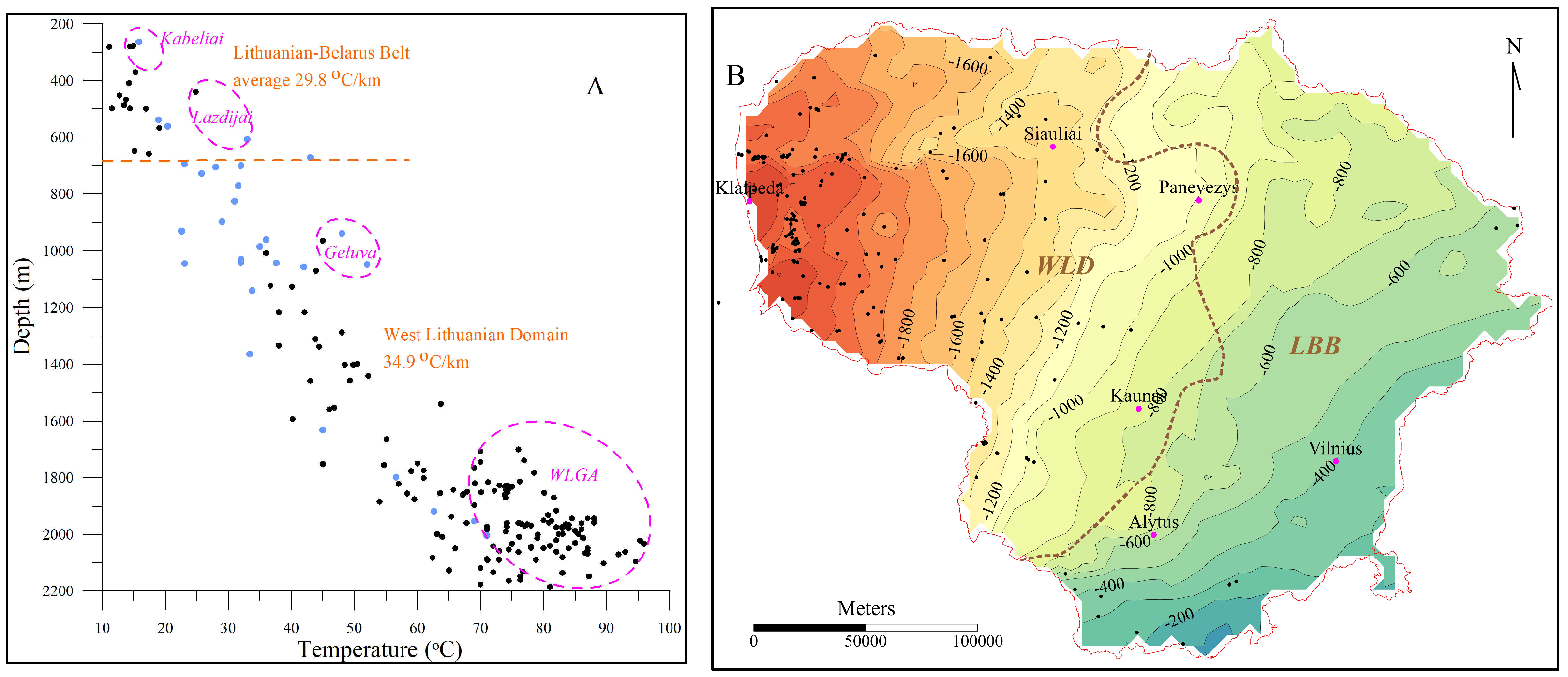
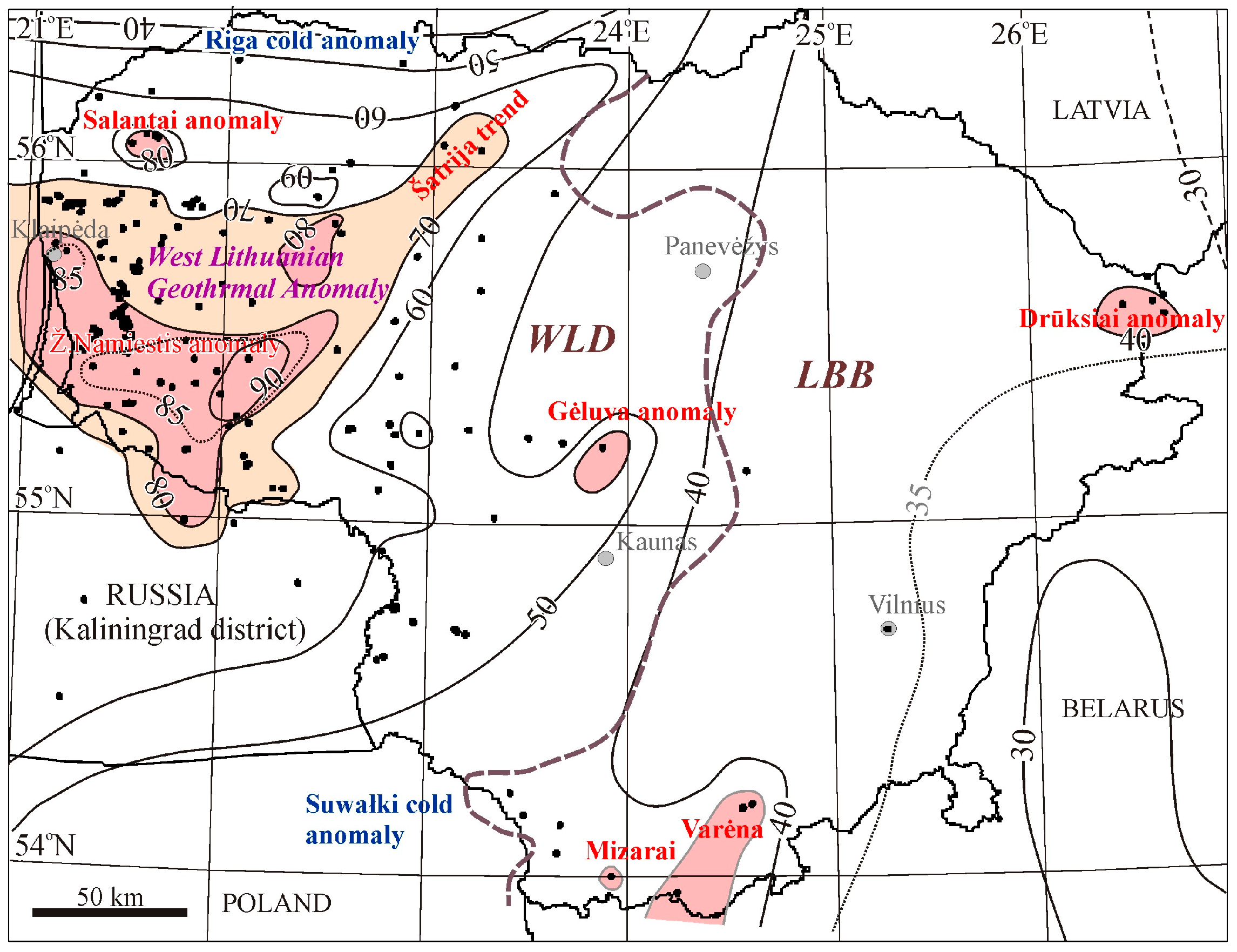

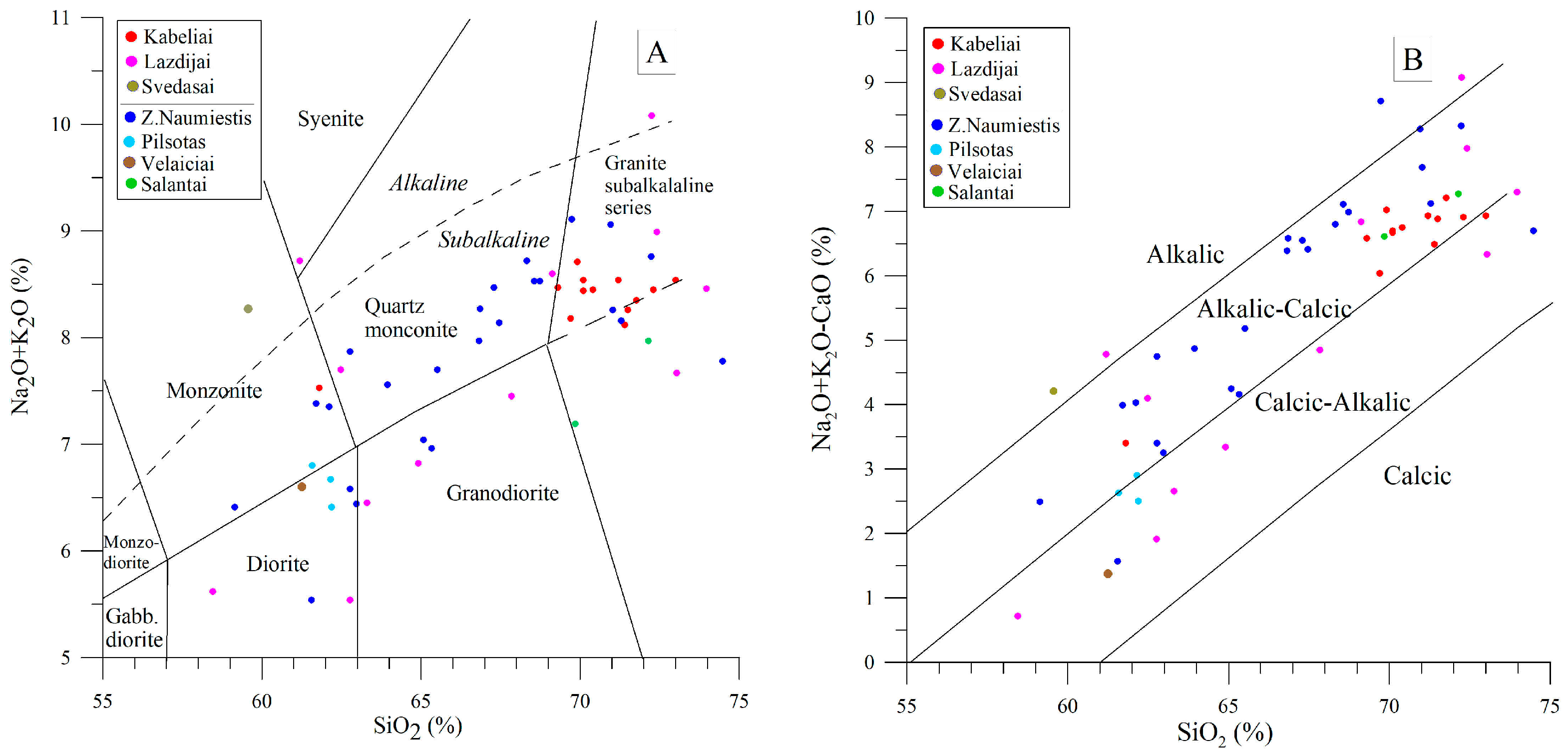
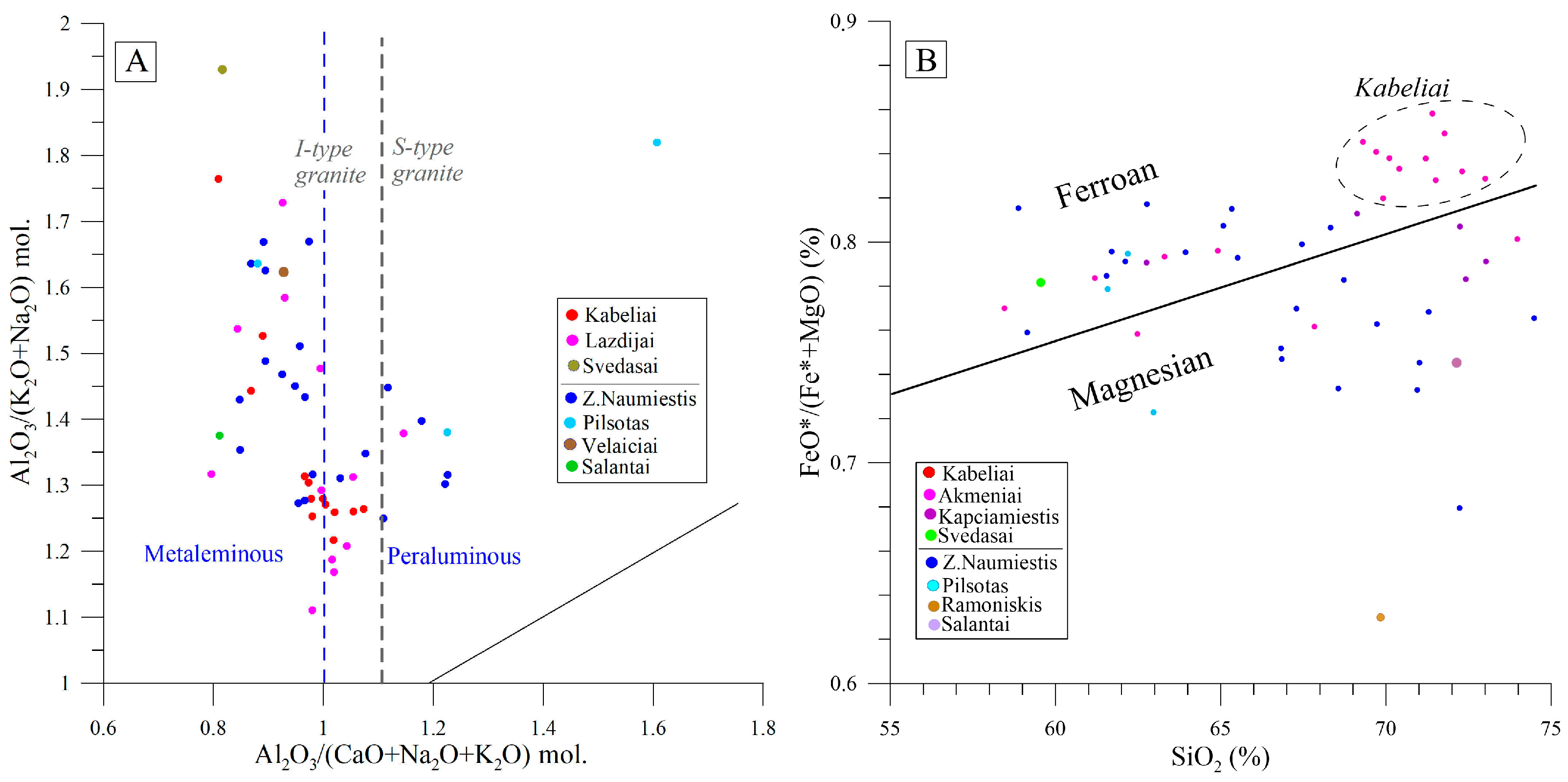
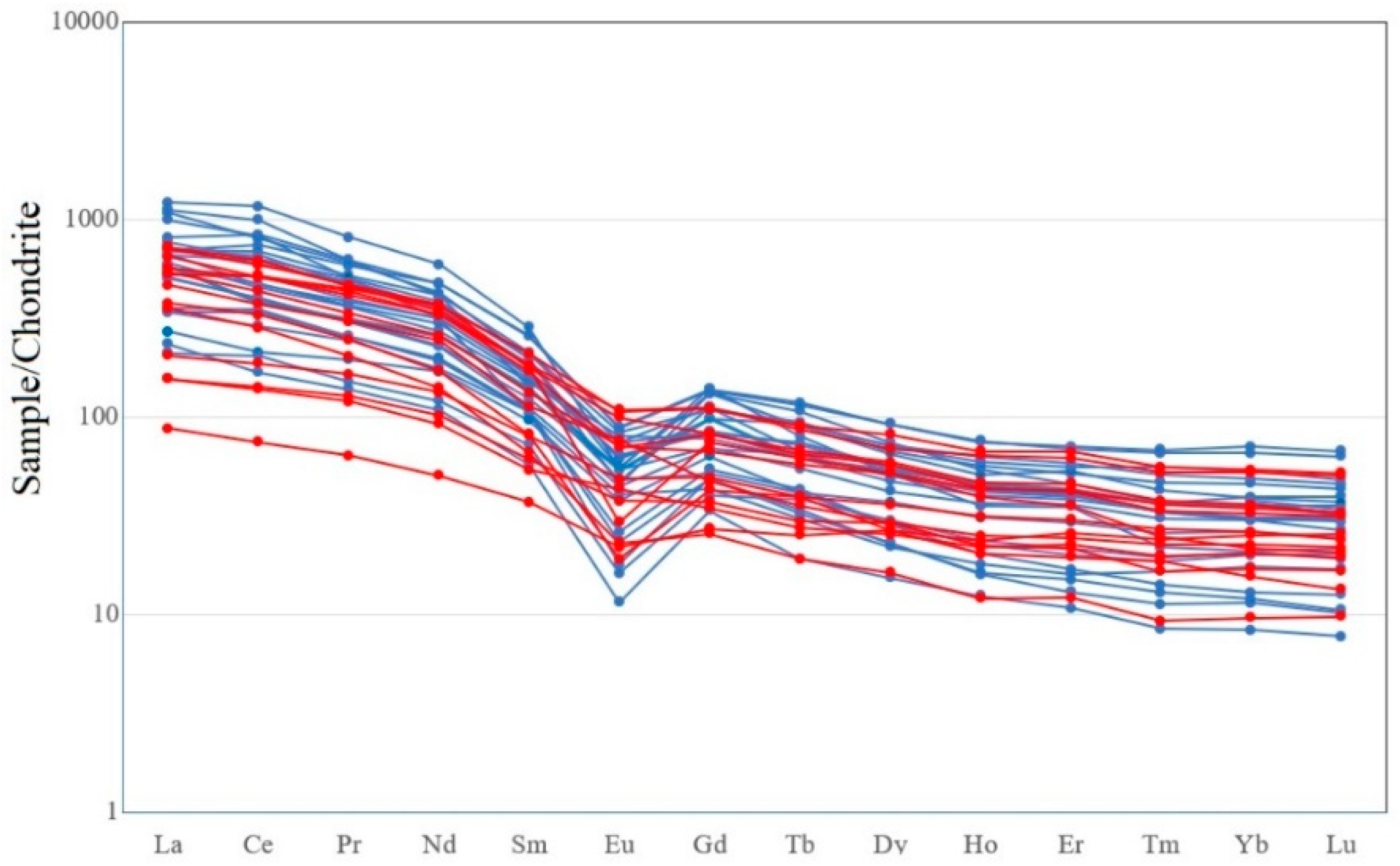
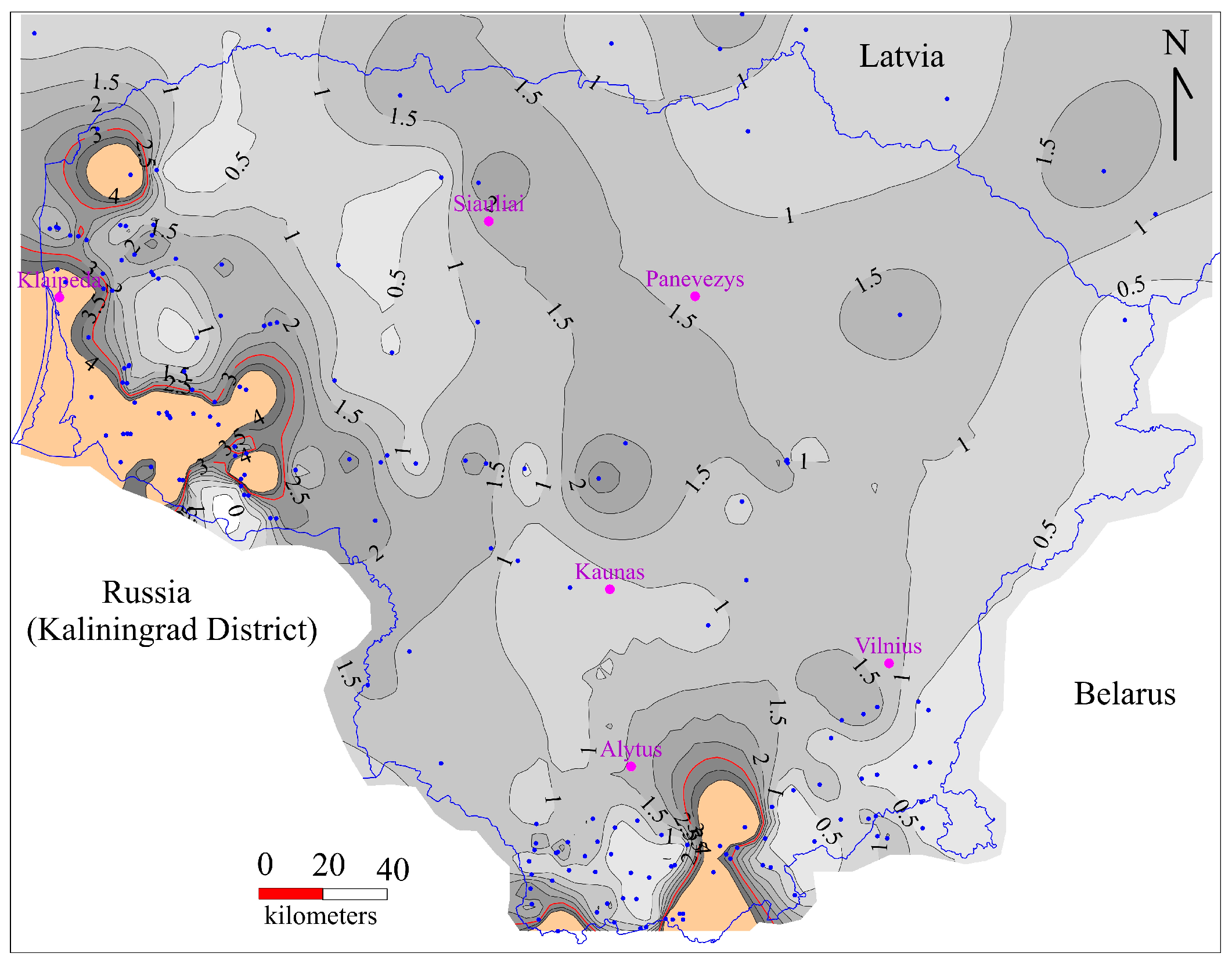
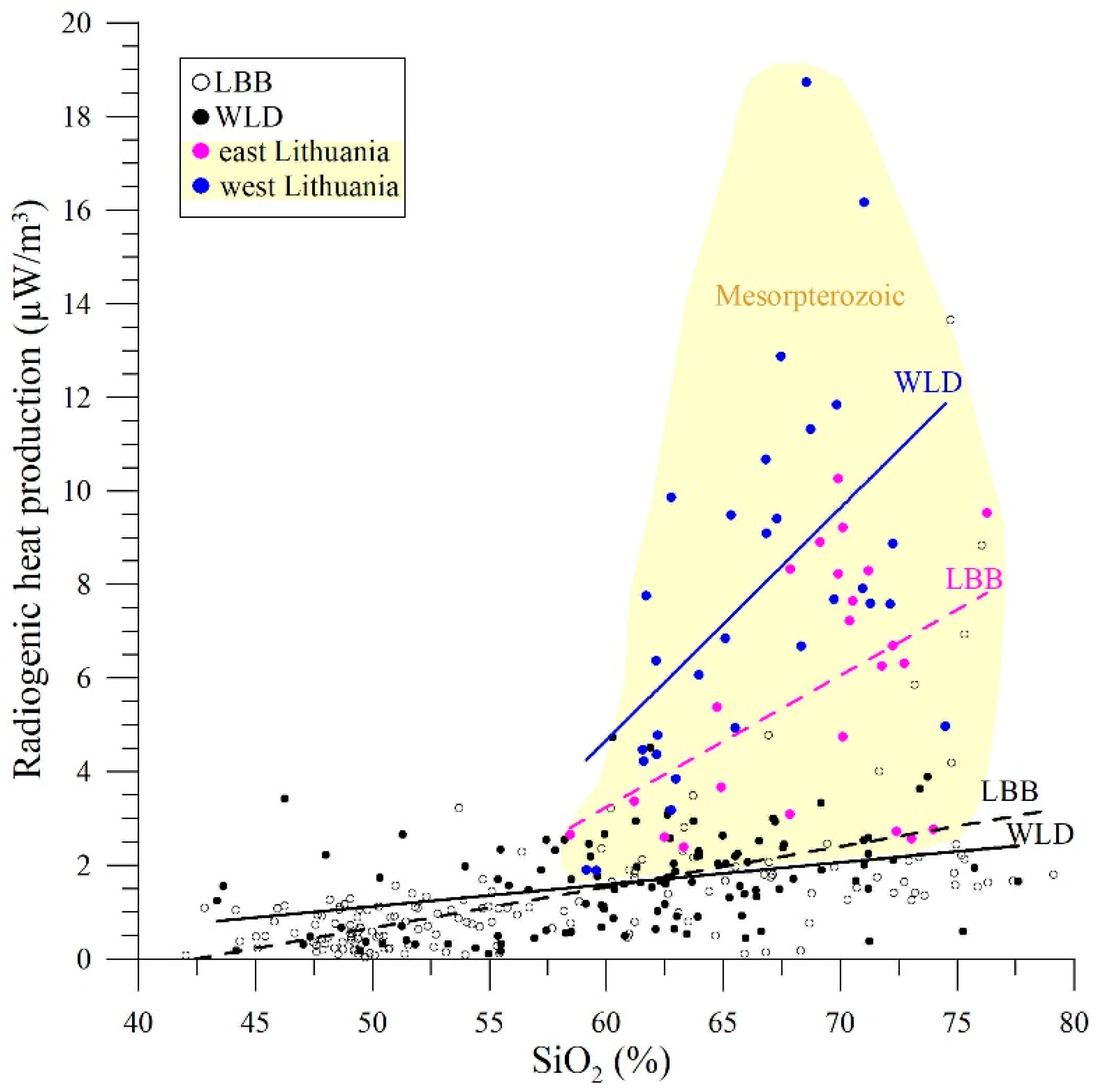

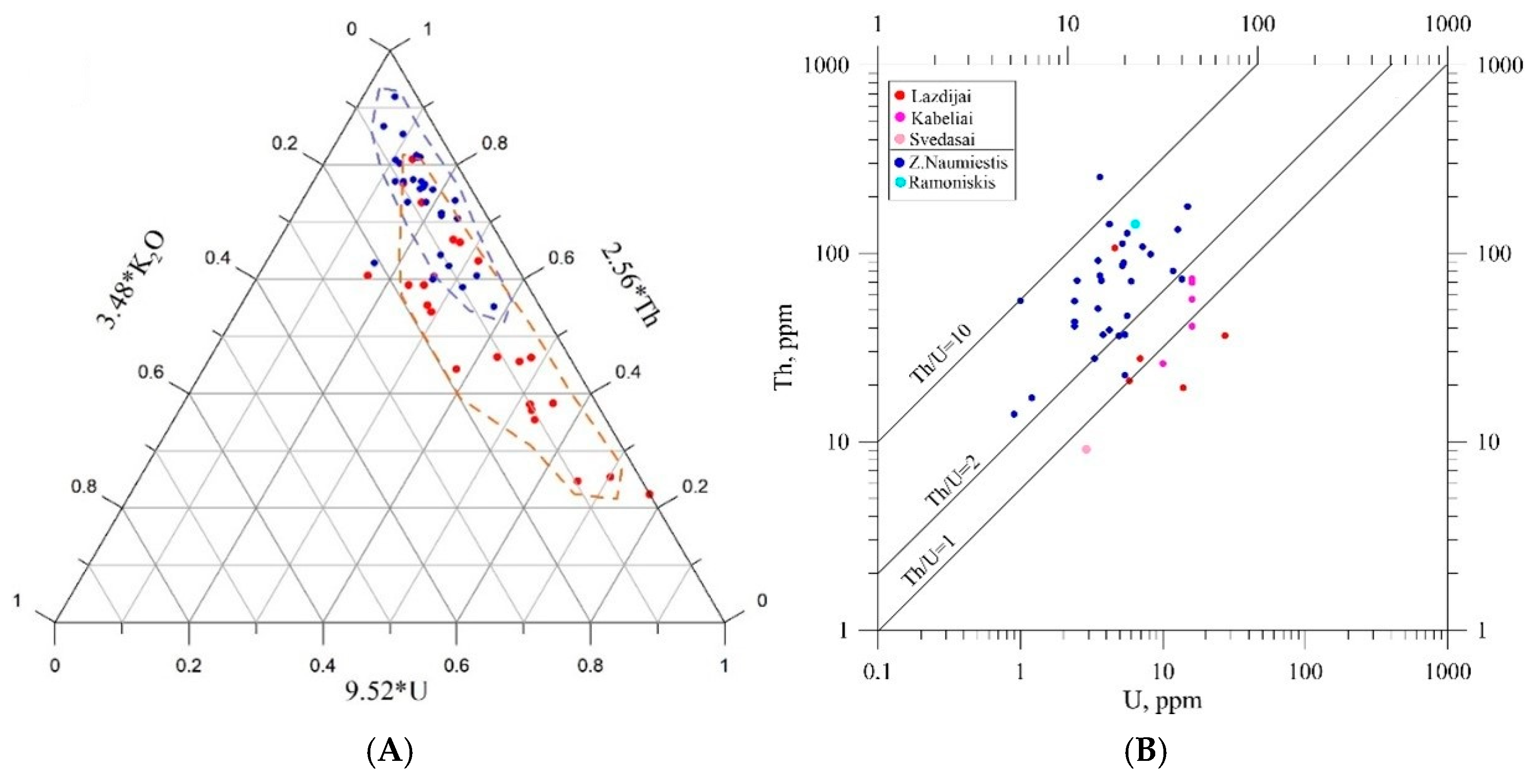
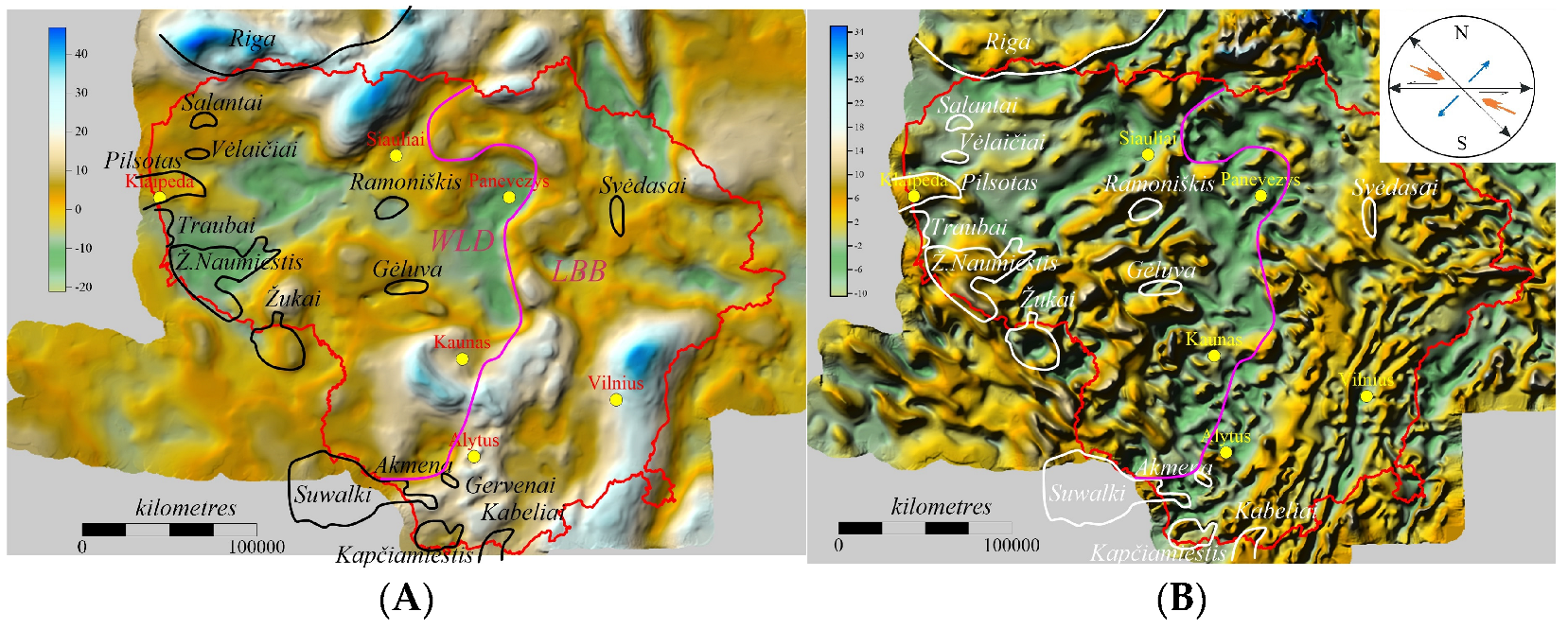
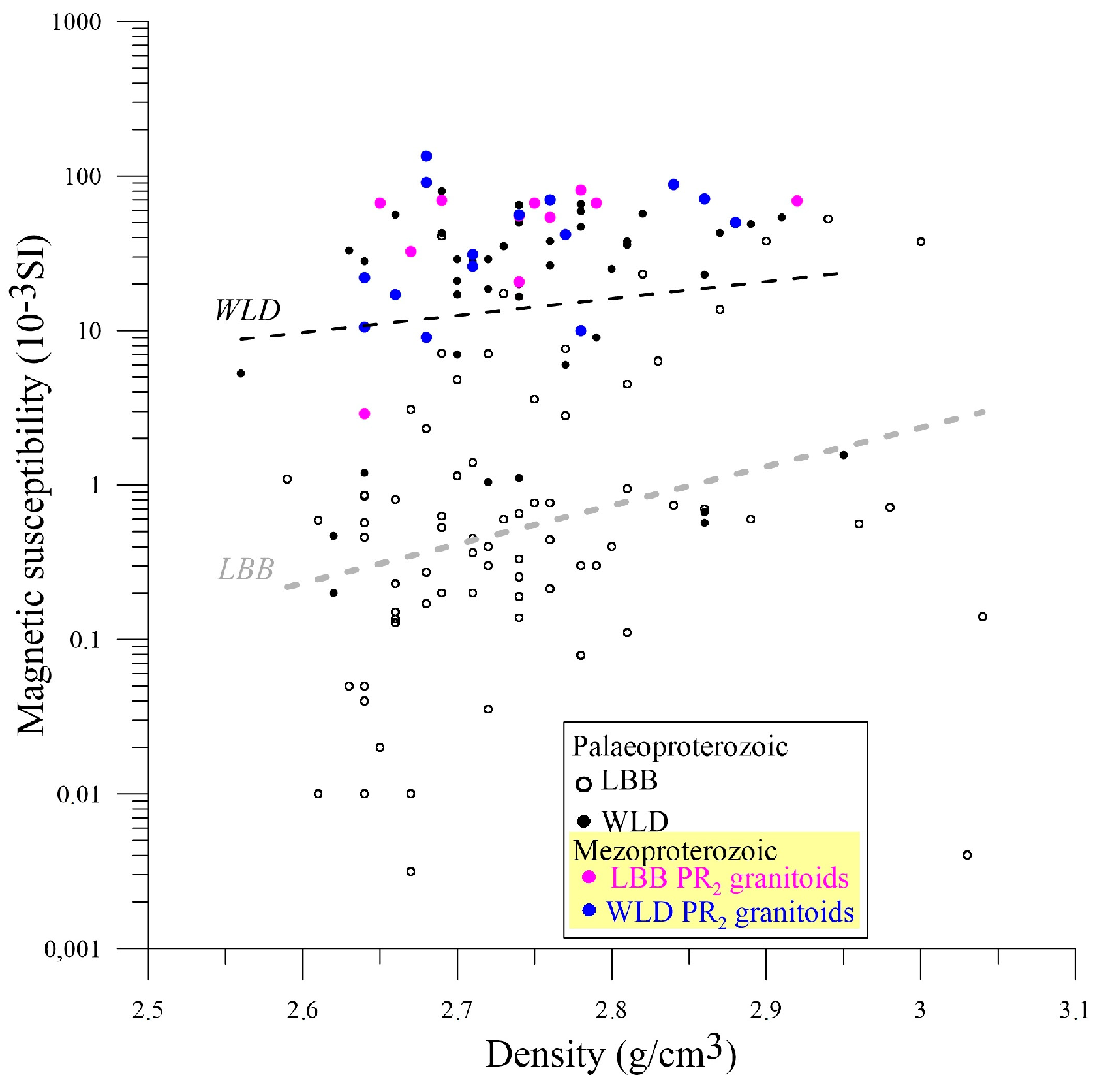
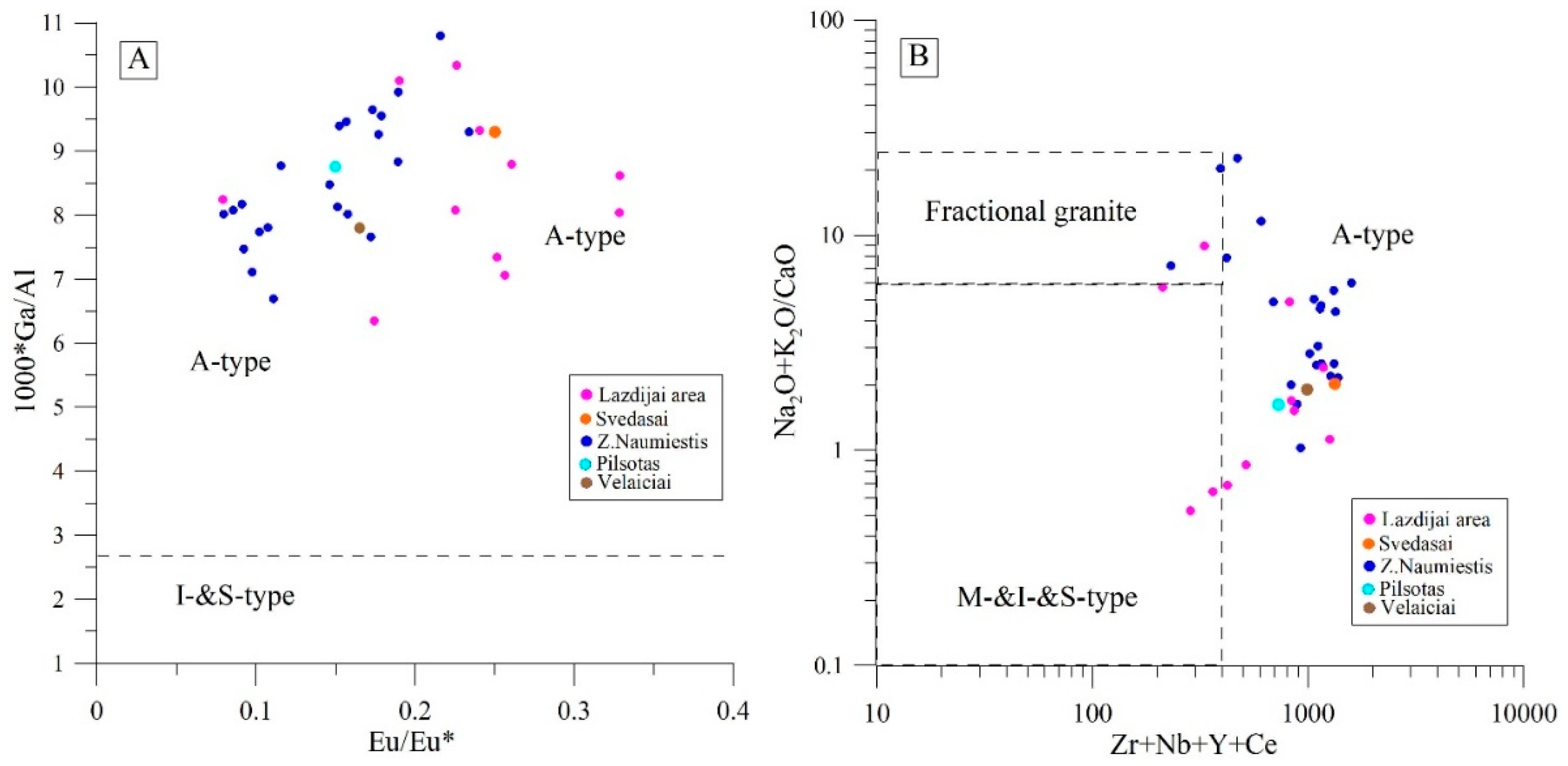
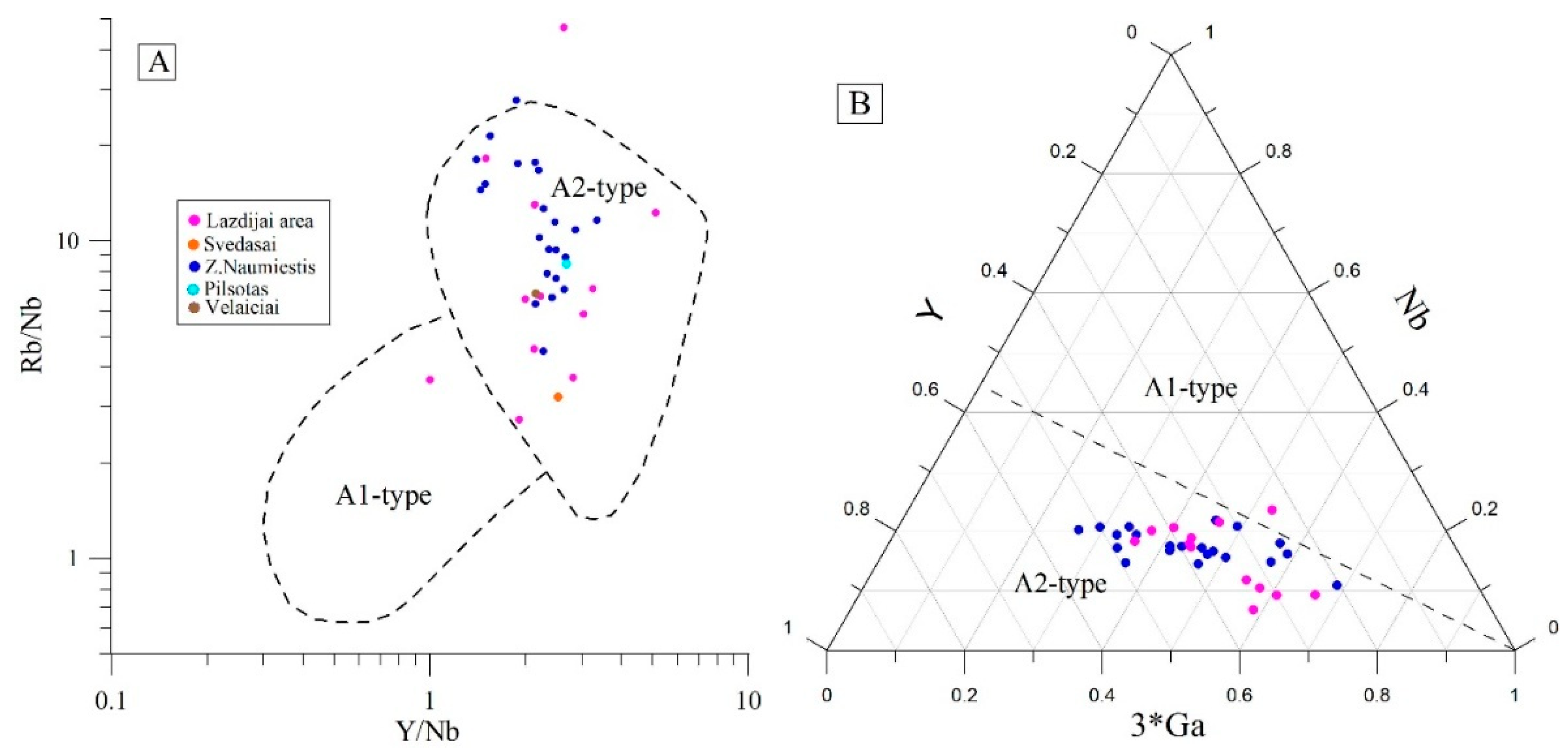
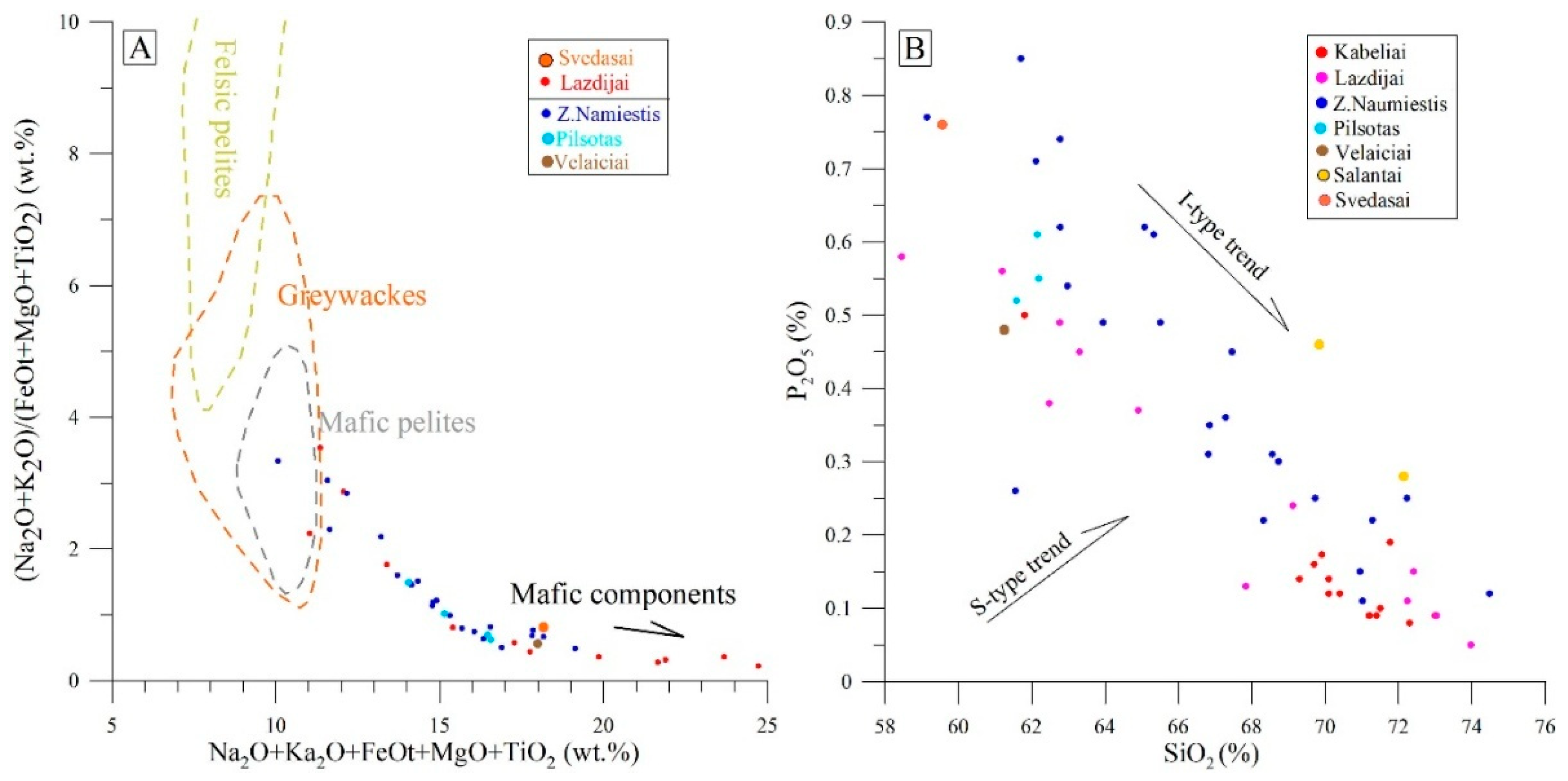
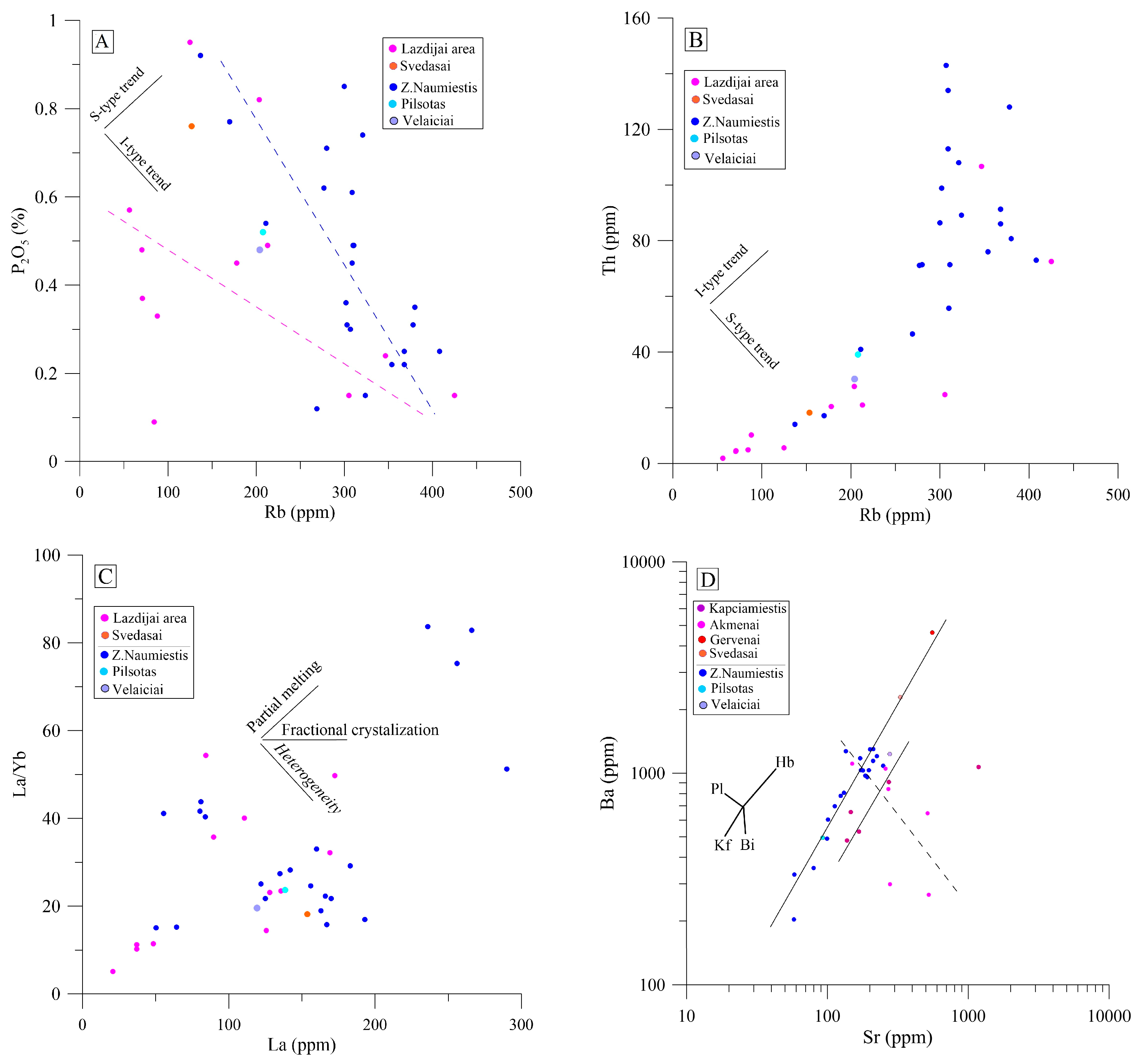
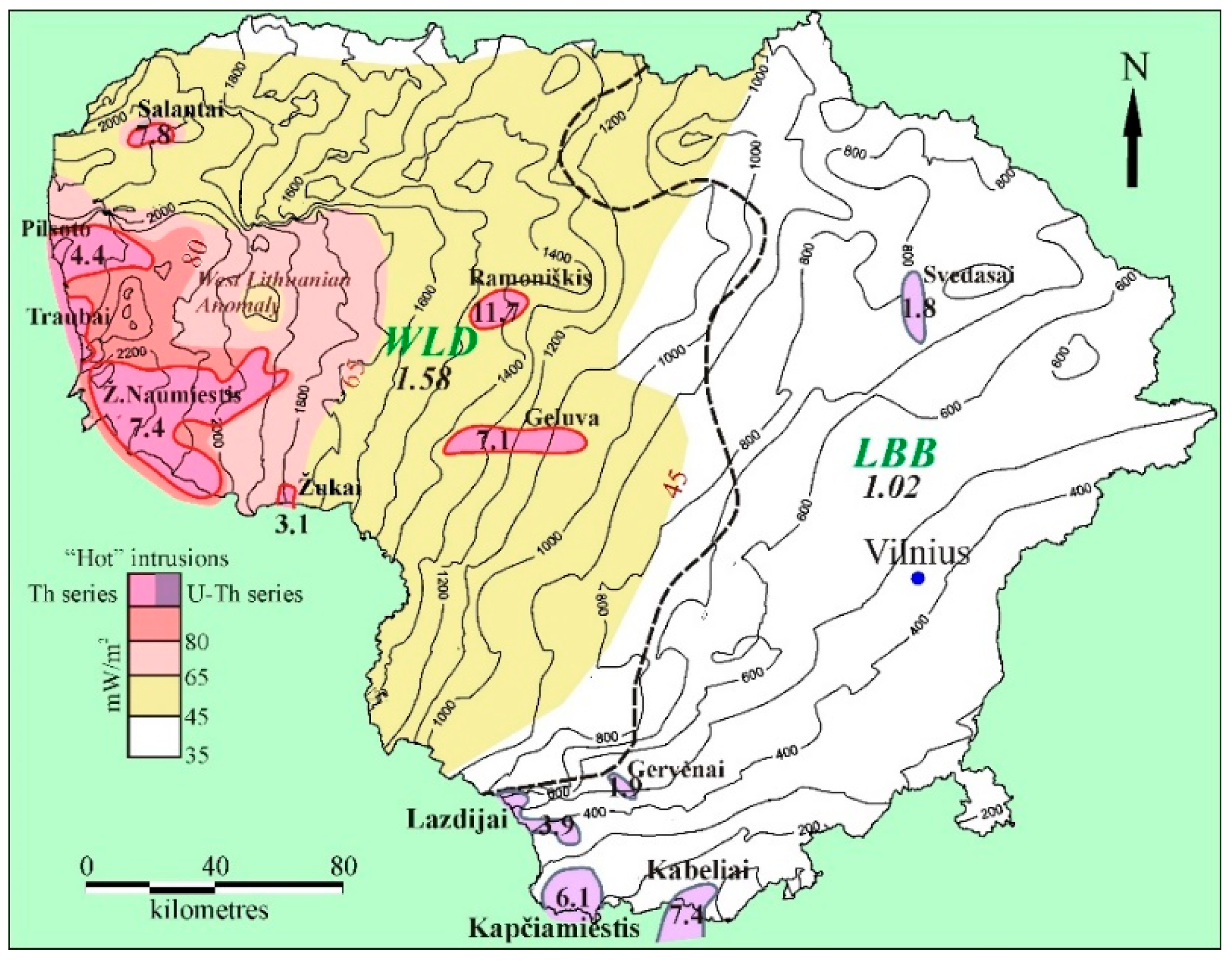
| Borehole | Rock | Age, Ma | Method/ Laboratory | Mineral | References |
|---|---|---|---|---|---|
| Vėlaičiai-2 | granodiorite | 1625 ± 6 | U-Pb LA-ICP-MS/SU * | zircon | Vejelyte et al., 2015 [36] |
| Genčiai-6 | granodiorite | 1622 ± 12 | U-Pb LA-ICP-MS/SU * | zircon | Vejelyte et al., 2015 [36] |
| Svėdasai-252 | granite | 1569 ± 9 | U-Pb SIMS/SU * | zircon | Vejelyte, 2012 [38] |
| Lazdijai-16 | Qtz monzodiorite | 1511 ± 5 | U-Pb NORDSIM/MNH * | zircon | Skridlaite et al., 2007 [39] |
| Marcinkon-4 | granite | 1505 ± 11 | U-Pb TIMS/MNH * | zircon | Sundblad et al., 1994 [40] |
| Varėna-987 | granite vein | 1512 ± 13 | U-Pb NORDSIM/MNH * | zircon | Skridlaite et al., 2023 [41] |
| Dzūkija-6 | granite vein | 1497 ± 7 | U-Pb NORDSIM/MNH * | zircon | Skridlaite et al., 2023 [41] |
| Purmaliai-2 | granodiorite | 1469 ± 3 | TIMS/IPGG RAS * | zircon | Motuza, 2022 [24] |
| Ž.Naum.-4 | granite | 1462 ± 8 | TIMS/IPGG RAS * | zircon | Motuza, 2022 [24] |
| Vabalai-1 | granite | 1459 ± 3 | TIMS/IPGG RAS * | zircon | Motuza, 2022 [24] |
| Rukai-2 | Qtz monzodiorite | 1447 ± 8 | NORDSIM/MNH * | zircon | Skridlaite et al., 2007 [39] |
| Gėluva-99 | granite | 1445 ± 8 | NORDSIM/MNH * | zircon | Skridlaite et al., 2007 [39] |
| Elm | SiO2 | Al2O3 | Fe2O3T | MgO | CaO | Na2O | K2O | TiO2 | P2O5 | MnO |
|---|---|---|---|---|---|---|---|---|---|---|
| West Lithuanian Domain | ||||||||||
| min | 58.90 | 12.50 | 1.78 | 0.49 | 0.40 | 0.33 | 3.53 | 0.24 | 0.12 | 0.02 |
| max | 74.50 | 14.60 | 9.35 | 2.67 | 5.68 | 2.53 | 7.10 | 2.04 | 0.92 | 0.15 |
| eve | 66.05 | 13.62 | 5.69 | 1.48 | 2.35 | 1.97 | 5.70 | 0.86 | 0.46 | 0.06 |
| Lithuanian–Belarus Belt | ||||||||||
| min | 48.61 | 12.58 | 2.49 | 0.62 | 1.01 | 2.05 | 1.42 | 0.27 | 0.09 | 0.03 |
| max | 73.03 | 17.09 | 14.52 | 5.74 | 8.79 | 3.96 | 6.94 | 2.76 | 0.95 | 0.35 |
| eve | 60.24 | 14.26 | 8.85 | 2.40 | 4.56 | 2.95 | 3.65 | 1.39 | 0.48 | 0.16 |
| Paleoproterozoic granodiorites and granites | ||||||||||
| min | 59.25 | 7.38 | 0.84 | 0.24 | 0.75 | 1.20 | 0.54 | 0.05 | 0.03 | 0.01 |
| max | 75.73 | 22.77 | 13.70 | 3.69 | 6.22 | 6.30 | 7.35 | 1.84 | 0.69 | 0.26 |
| eve | 65.03 | 15.00 | 6.54 | 1.72 | 3.32 | 2.75 | 3.56 | 0.87 | 0.22 | 0.13 |
| Elem | Ba | Sc | Co | Cs | Ga | Hf | Nb | Rb | Sn |
|---|---|---|---|---|---|---|---|---|---|
| West Lithuanian Domain | |||||||||
| min | 203 | 1.8 | 2.9 | 0.5 | 17.7 | 3.6 | 9.7 | 137.0 | 0.9 |
| max | 1313 | 23.0 | 23.3 | 3.8 | 29.8 | 22.6 | 48.4 | 408.0 | 8.0 |
| aver | 948 | 13.1 | 10.8 | 1.7 | 21.9 | 15.4 | 27.8 | 296.2 | 3.4 |
| Lithuanian–Belarus Belt | |||||||||
| min | 266 | 5.0 | 3.0 | 0.5 | 15.5 | 4.0 | 6.5 | 56.3 | 2.0 |
| max | 4623 | 39.0 | 38.9 | 5.2 | 27.5 | 23.9 | 44.7 | 425.1 | 7.0 |
| aver | 1136 | 19.2 | 18.3 | 1.9 | 22.2 | 11.5 | 23.9 | 176.5 | 3.8 |
| Elem | Sr | Rb | Ta | Th | Tl | U | V | Zr | Y |
| West Lithuanian Domain | |||||||||
| min | 58 | 137 | 0.4 | 14 | 0.1 | 0.9 | 14 | 99.4 | 18.1 |
| max | 370 | 408 | 138.5 | 254 | 1.8 | 13.6 | 157 | 829 | 117 |
| aver | 174 | 296 | 12.0 | 84.13 | 0.6 | 5.2 | 76 | 536 | 64 |
| Lithuanian–Belarus Belt | |||||||||
| min | 138 | 56 | 0.2 | 1.8 | 0.2 | 1.1 | 16 | 129.6 | 17.1 |
| max | 1181 | 425 | 3.0 | 106.7 | 1.3 | 6.9 | 249 | 915.7 | 99.6 |
| aver | 368 | 176 | 1.0 | 24.5 | 1.2 | 3.6 | 118 | 405 | 52.4 |
| Elm | La | Ce | Pr | Nd | Sm | Eu | Gd | Tb | Dy | Ho | Er | Tm | Yb | Lu |
|---|---|---|---|---|---|---|---|---|---|---|---|---|---|---|
| West Lithuanian Domain | ||||||||||||||
| min | 50.2 | 103 | 12.9 | 49.6 | 8.5 | 0.65 | 6.68 | 0.69 | 3.79 | 0.68 | 1.73 | 0.21 | 1.35 | 0.19 |
| max | 290.2 | 716 | 75.4 | 270 | 42.3 | 4.99 | 27.8 | 4.28 | 22.7 | 4.13 | 11.3 | 1.69 | 11.4 | 1.65 |
| aver | 150 | 338 | 38.2 | 142 | 23.3 | 2.95 | 17.09 | 2.39 | 12.41 | 2.22 | 6.04 | 0.81 | 5.24 | 0.76 |
| Lithuanian–Belarus Belt | ||||||||||||||
| min | 20.7 | 45.7 | 5.94 | 23.1 | 5.5 | 1.08 | 5.1 | 0.69 | 4.03 | 0.66 | 1.95 | 0.23 | 1.55 | 0.24 |
| max | 173 | 380.9 | 43.1 | 169.2 | 31.0 | 6.14 | 22.1 | 3.29 | 20.07 | 3.66 | 10.69 | 1.38 | 8.7 | 1.28 |
| aver | 101 | 222.7 | 27.1 | 103.3 | 17.7 | 3.27 | 12.13 | 1.79 | 10.62 | 1.94 | 5.57 | 0.72 | 4.56 | 0.66 |
| Average | ∑REE | LREE | HREE | Ratio L/H | (La/Yb)N | Eu/Eu* | ||||||||
| WLD | 741.1 | 691.3 | 49.8 | 13.9 | 23.2 | 0.15 | ||||||||
| LBB | 513.0 | 471.7 | 41.3 | 11.4 | 17.2 | 0.22 | ||||||||
Disclaimer/Publisher’s Note: The statements, opinions and data contained in all publications are solely those of the individual author(s) and contributor(s) and not of MDPI and/or the editor(s). MDPI and/or the editor(s) disclaim responsibility for any injury to people or property resulting from any ideas, methods, instructions or products referred to in the content. |
© 2025 by the authors. Licensee MDPI, Basel, Switzerland. This article is an open access article distributed under the terms and conditions of the Creative Commons Attribution (CC BY) license (https://creativecommons.org/licenses/by/4.0/).
Share and Cite
Šliaupa, S.; Motuza, G. High Heat Producing Mesoproterozoic Granitoids and Their Impact on the Geothermal Field in Lithuania, Baltic Basin. Appl. Sci. 2025, 15, 10480. https://doi.org/10.3390/app151910480
Šliaupa S, Motuza G. High Heat Producing Mesoproterozoic Granitoids and Their Impact on the Geothermal Field in Lithuania, Baltic Basin. Applied Sciences. 2025; 15(19):10480. https://doi.org/10.3390/app151910480
Chicago/Turabian StyleŠliaupa, Saulius, and Gediminas Motuza. 2025. "High Heat Producing Mesoproterozoic Granitoids and Their Impact on the Geothermal Field in Lithuania, Baltic Basin" Applied Sciences 15, no. 19: 10480. https://doi.org/10.3390/app151910480
APA StyleŠliaupa, S., & Motuza, G. (2025). High Heat Producing Mesoproterozoic Granitoids and Their Impact on the Geothermal Field in Lithuania, Baltic Basin. Applied Sciences, 15(19), 10480. https://doi.org/10.3390/app151910480






